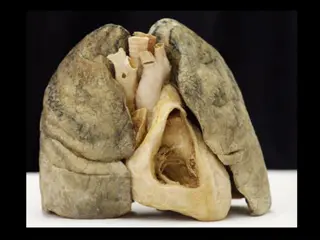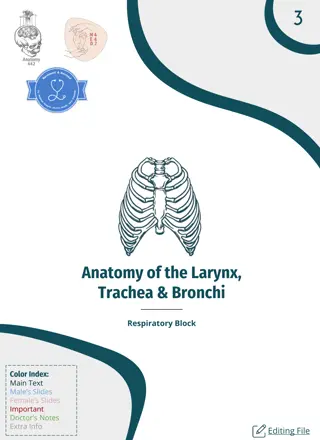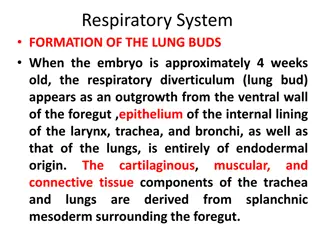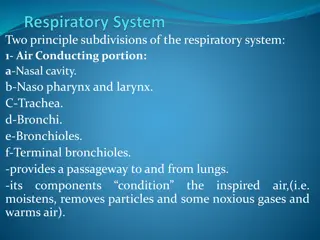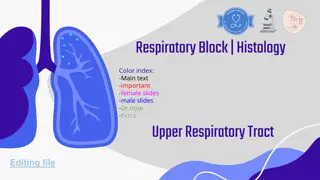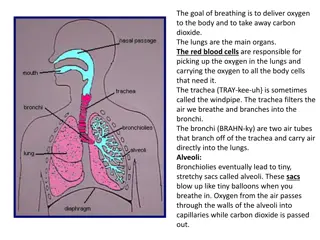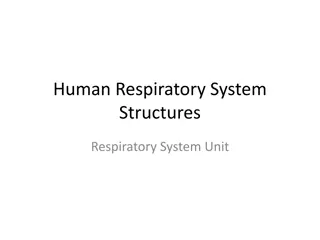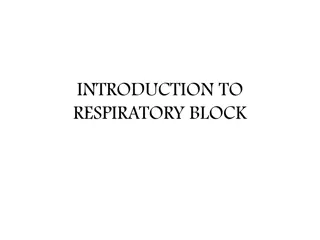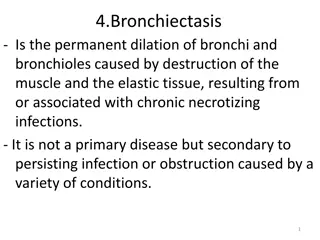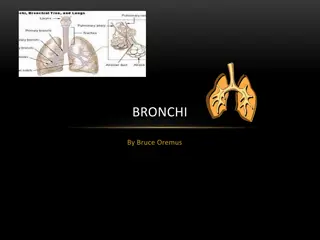
Bronchi and Their Importance in the Respiratory System
Explore the anatomy of bronchi, the primary airways conducting air into the lungs. Learn about the differences between right and left bronchi, bronchial tree structure, and the conducting zone of the airways. Discover how bronchi play a vital role in respiration.
Download Presentation

Please find below an Image/Link to download the presentation.
The content on the website is provided AS IS for your information and personal use only. It may not be sold, licensed, or shared on other websites without obtaining consent from the author. If you encounter any issues during the download, it is possible that the publisher has removed the file from their server.
You are allowed to download the files provided on this website for personal or commercial use, subject to the condition that they are used lawfully. All files are the property of their respective owners.
The content on the website is provided AS IS for your information and personal use only. It may not be sold, licensed, or shared on other websites without obtaining consent from the author.
E N D
Presentation Transcript
BRONCHI 1
What are Bronchi A bronchus, which is also known as a main or primary bronchus, represents the airway in the respiratory tract that conducts air into the lungs. The plural for bronchus is bronchi. Each bronchus further branches into smaller tubes. 2
The differences between the two bronchi The right bronchus The left bronchus 2.5 centimeters (one inch) long 5 centimeters (two inches) long Shorter Longer & narrower It enters the lung opposite T5 It enters the lung opposite T6 More in line with trachea Less in line with trachea Gives 3 lobar bronchi, on entering the hilum, it divides into a middle and an inferior lobar bronchus. Gives 2 lobar bronchi, on entering the hilum of the left lung, the principal bronchus divides into a superior and an inferior lobar bronchus. The right pulmonary artery crosses in front of the stem of the right bronchus below the origin of its 1st branch. The left pulmonary artery crosses in front of the left bronchus before it gives its 1st branch. The orifice of the right bronchus being larger The orifice of the left bronchus being smaller The azygos vein arches over it from behind The arch of aorta crosses above the left bronchus from in front backwards Foreign bodies usually enter the right bronchus placed nearly in line with the trachea foreign bodies usually enter the left bronchus less commonly 4
Bronchi The trachea divides into the left and right main bronchus, which is known as the tracheal bifurcation, at the level of the sternal angle and of the fifth thoracic vertebra (or up to two vertebrae higher or lower, depending on lung volume changes due to breathing). 5
Bronchial tree Mainstem bronchi divide into the lobar bronchi (secondary) and subsequently into the segmental (tertiary) bronchi. Arteries, veins, and lymphatics also enter the lungs at the hilum along with the bronchi. A bronchopulmonary segment is a portion of lung that is supplied by a segmental bronchus and its adjacent blood vessels. 6
The initial 16-17 generations of bronchi make up the conducting zone of the airways and do not participate in gas exchange. The surface of the airways that does not contribute to gas exchange is referred to as dead space. 7
Relations of the bronchi The bronchi arise in front of esophagus at the level of sternal angle. A group of tracheobronchial lymph nodes lies in the angle between the bronchi. The left bronchus crosses in front of esophagus and descending aorta. The right & left pulmonary arteries cross in front of the right & left bronchi. The relation of upper & lower pulmonary veins can be seen by looking to the root of the lungs. The arch of the azygos vein arches above the right bronchus from behind to join superior vena cava while the arch of the aorta arches above the left bronchus. Each vagus nerve breaks up on the posterior surface of its bronchus to form posterior pulmonary plexus. 8
Right Main (Primary) Bronchus The branch that leads into the right lung is called the right main or primary bronchus Divisions and Anatomy The right primary bronchi branches into three secondary or lobar bronchi, the superior (upper), middle, and inferior (lower) lobar bronchi. The right superior secondary bronchus is also known as the eparterial bronchus because it is the only bronchial tube originating above the pulmonary artery s level . Bronchial lymph nodes are located at the origin point of each of the lobar bronchi. The secondary bronchi then further subdivide into ten tertiary or segmental bronchi. These tertiary bronchi then give rise to the subsegmental bronchi, which then leads to the smallest branches of a bronchus, the bronchioles . 10
Left Main (Primary) Bronchus The left primary bronchus supplies air to the left lung , passes from beneath the aortic arch, crossing the esophagus, thoracic duct, and descending aorta from the front. Divisions and Anatomy Like the right main bronchus, the left one also divides into two lobar bronchi, the superior and inferior lobar bronchi [11]. The lobar bronchi then subdivide into eight tertiary or segmental bronchi . The tertiary bronchi continue to divide into smaller tubes to become subsegmental bronchi and then bronchioles. 11
Bronchial Wall Anatomy Like the trachea, the bronchi are also surrounded by c-shaped cartilaginous rings. However, the smaller bronchial tubes have irregular cartilaginous sheets instead of rings to support them. These cartilage structures, along with a layer of smooth muscle bands, control the diameter of the lumen of the bronchi during inhalation and exhalation . 12
THANK YOU! 16

